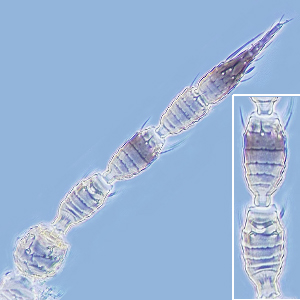Figures
Fig. 1: Antenna (inset: III. and IV. antennal segment)
Fig. 2: Head dorsal with ocellar triangle
Fig. 3: Pronotum
Fig. 4: Meso- and metanotum
Fig. 5: Fore- and hindwing
Fig. 6: Sternite III and IV
Fig. 7: Tergites IV and V
Fig. 8: Tergites VIII-IX
Taxonomic Information
Species:
Dendrothripoides innoxius (Karny, 1914)
Synonyms:
Scirtothrips gladiiseta Girault, 1933
Heliothrips ipomeae Bondar, 1930
Tryphactothrips mundus Karny, 1927
Tryphactothrips mediosignatus Karny, 1925
Dendrothripoides ipomoeae Bagnall, 1923
Euthrips innoxius Karny, 1914
Common name:
Sweet-potato thrips
Present taxonomic position:
Family: Thripidae Stephens, 1829
Subfamily: Thripinae (Stephens) Karny, 1921
Genus: Dendrothripoides Bagnall, 1923
Species Recognition
General information about the genus Dendrothripoides:There are four species included in this genus all have have tooth-like michrotrichia on the lateral sides of the abdominal tergites and with the pronotum with two long setae at the posterior margin.
Typical character states of Dendrothripoides innoxius:
Body color
Mainly pale or yellow, with some darker markings
Antennae
Number of antennal segments: 8
Segment IV - forked sensorium: extending to a point at least 30% distal to base of segment V
Segments II and III shape: more or less symmetric
Segments III & IV sensoria: emergent and forked
Base of sensorium on antennal segment VI: no more than 2 times as wide as base of nearest seta
Terminal antennal segments: rarely elongate
Head:
Distance between bases of ocellar setae III: greater than width of first ocellus
Head shape between compound eyes: not prolonged
Ocellar setae III on head: arising on anterior margin of, or in front of, ocellar triangle
Surface of head, pronotum and fore legs: without strong reticulate sculpture
Ocellar setae I in front of anterior ocellus: absent
Prothorax
Number of pairs of elongate pronotal setae: 0-3
Number of pairs of elongate posteroangular pronotal setae: 0-1
Pronotum shape: rectangular
Mesothorax
Mesothoracic endofurca: without median spinula
Metathorax
Metanotal median setae length: shorter than lateral metanotal setae
Metanotal median setae position: arising behind anterior margin
Metanotum: without campaniform sensilla
Metanotum major sclerite: with two major sclerites, metascutum and metascutellum
Metanotum median area: with at least some equiangular reticulation
Metanotum sculpture: without dominant sculptured triangle medially
Metathoracic endofurca: transverse, sometimes with simple median spinula
Wings
Wings: absent, or not longer than thorax width or present and more than half as long as abdomen
First vein of forewing: distinct from costal vein
Forewing anterior margin: with cilia but no long setae
Forewing color: alternating bands of dark and light
Forewing costal fringe of cilia: arising at anterior margin of wing
Forewing costal setae at middle of wing: minute and scarcely extending beyond wing margin
Forewing first vein setal row: incomplete, with setae not closely and uniformly spaced
Forewing posterior margin cilia: undulated near apex
Forewing second vein setal row: incomplete, with setae not closely and uniformly spaced
Forewing surface: not reticulate
Forewings: with veins, setae and microtrichia
Legs
Fore tibial apex: not extending around fore tarsus
Mid and hind tarsi: with two segments
Abdomen:
Abdominal pleurotergites: not covered in microtrichia
Abdominal segment X: never tubular, longitudinally incomplete ventrally in both sexes
Abdominal sternite II: with marginal setae but no discal setae
Abdominal sternite III of female: without glandular areas
Abdominal sternite VII median marginal setae: arising at margin
Abdominal sternites IV , V and VI: with marginal setae but no discal setae
Abdominal tergites: without curved wing-retaining setae
Abdominal tergites IV & V median setal pair: much shorter than distance between their bases
Abdominal tergites V-VII: without paired ctenidia, sometimes with irregular microtrichia
Setae on abdominal tergite X: slender
Surface of lateral thirds of abdominal tergites: with many irregular and large microtrichia
Ctenidia on tergite VIII: not present, but groups of microtrichia
Tergite VIII posteromarginal comb of microtrichia: absent
Biology
Life history:
As with other thrips species the life cycle from egg to adult is dependent on temperature. The full cycle can take less than one week to over a month and adults may live for more than one month producing several generations in one year depending on seasonal weather (Lewis, 1973).
Host plants:
Ipomoea (sweet potato, I. batalas, and chinese water spinach, I. aquatica)
Vector capacity:
None identified
Current known distribution:
Oriental region, Pacific region, South America, Panama, Carribean Islands
Additional notes:
This species was originally described by Karny (1914) and the life history is not currently documented.
Bibliography
Karny, H (1914): Beiträge
zur Kenntnis der Gallen von Java. Zweite Mitteilung über die javanischen
Thysanopterocecidien und deren Bewohner. Zeitschrift für wissenschaftliche
Insektenbiologie. 10: 355–369.
Lewis, T (1973): Thrips. Their Biology, Ecology and
Economic Importance. Academic Press, New York, xvi, 350pp.
Moritz G, Morris DC, Mound LA (2001): ThripsID - Pest thrips of the world. ACIAR and CSIRO Publishing Collingwood, Victoria, Australia, CDROM ISBN 1 86320 296 X.
Moritz G, Mound LA, Morris DC, Goldarazena A (2004): Pest thrips of the world - an identification and information system using molecular and microscopial methods. CBIT, University of Queensland,CDROM ISBN 1-86499-781-8.
Mound, LA & Marullo, R (1996): The thrips of Central
and South America: An introduction (Insecta: Thysanoptera). Associated
Publishers, Gainesville.
Links:
Mound, LA (2005): Thysanoptera (Thrips) of the World
- A Checklist. http://www.ento.csiro.au/thysanoptera/worldthrips.html









